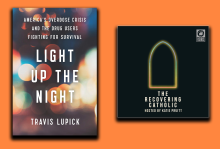Arts & Culture

WHAT IS FREEDOM, really? When we first meet the titular narrator of Kaitlyn Greenidge’s novel Libertie, the year is 1860 and Libertie Sampson is a child in Kings County, New York, witnessing a miracle: Her mother, Dr. Sampson, raises a man escaping slavery “from the dead.” Her father, a former slave who died before her birth, named Libertie after his “longing” for “the bright, shining future he was sure was coming.” Libertie grows up watching her mother work, learning about the body’s ailments alongside the plants and remedies that can allay suffering. Perhaps this—the ability to heal, to gain access to a position other Black women could not, to guide others to life outside slavery—is the freedom Dr. Sampson envisions for her daughter, who is raised to follow in her mother’s footsteps.
But Libertie soon learns that she and her mother do not have the same privileges: Where her mother’s light skin allowed her access to medical school, Libertie’s dark skin means she cannot enter the same rooms as her mother. When white patients recoil from Libertie’s touch—and her mother does not defend or shield her—Libertie begins to lose faith in her mother’s version of freedom.

The film opens when Venus and Serena are already near teenhood and tennis stardom. We don’t suffer through scenes of the two first learning to swing a racket, and this allows the movie to focus on the true challenge the sisters faced: the classism and racism of rich, white, tennis institutions that had little time for two Black girls from Compton, Calif. — an issue that has improved but still exists in U.S. tennis.

THERE'S A MOMENT in the Hulu miniseries Dopesick in which a Drug Enforcement Administration officer walks into her supervisor’s office to talk about the wave of opioid addiction that was, in the early 2000s, already rampant in central Appalachia. Earlier she’d been told that the higher-ups weren’t interested in “pill mill” doctors and pharmacy burglaries. They wanted to go after the cartel. Well, says Agent Bridget Meyer (played by Rosario Dawson), she’s found the cartel—and proceeds to recite the Stamford, Conn., address of Purdue Pharma Inc.
Over the past few years, documents uncovered in various lawsuits have made it clear that Purdue Pharma, privately owned by members of the Sackler family, was “the cartel” behind a plague of addiction and overdose that has so far killed more than a half-million Americans. And the kingpin of this cartel was Purdue’s Richard Sackler, former company president and co-chair of the board of directors.
In 1996, Sackler conceived an ambition to cure the world of chronic pain—and multiply the family fortune—with the “miracle drug” OxyContin, a powerful time-released painkiller. Sackler hired an army of attractive young sales reps and aimed them at small-town doctors in parts of the country with lots of painful workplace injuries from things like logging and coal mining. Misery, dependency, and death followed as the drug spread unchecked like wildfire for an entire decade.

Rediscovering God
Katie Pruitt’s debut album, Expectations, explored growing up gay and Catholic in the American South. On her new podcast series, The Recovering Catholic, she speaks with comedians, religious leaders, and other artists about how they see God and what spirituality means today. Osiris Media.

SOME TV SHOWS are as great as our greatest literature. Programs such as The Sopranos, The Wire, Mad Men, and Breaking Bad are Dickensian in their sprawl and Shakespearean in their tragic characters’ deceptions. But one show in this current Golden Age of television is the most oft-overlooked of its peers, one whose greater feat—or unfairness to screenwriters—is that it’s not scripted. I’m talking about A&E’s reality show Hoarders.
I’m not kidding. What often draws people to watch those suffering from hoarding disorder and the psychologists, professional organizers, and loved ones trying to help them overcome mental illness is the typical reality TV magnet: Seeing the life of someone worse off than you. But there’s more to Hoarders than that. A good episode is nothing less than a short story similar to those by Alice Munro, vivid in its deep analysis of real life, family dynamics, and psyches in danger and repair. Almost every night for the past month, watching has been like studying fiction writing in some of the best (and cheapest) creative writing courses I’ve ever taken.

HISTORY HAS PAID personal attention to Lawrence Joseph, a Maronite Catholic from Detroit. In 1967, when Joseph was 19 and just finished with his freshman year at the University of Michigan, his father’s grocery-liquor store was looted and burned during the Detroit Rebellion. The five-day uprising of Black people reacting in part to police abuse and brutality and its fierce suppression by law enforcement and the National Guard made him “acutely conscious of America’s deeply systemic violence.”
Joseph, a poet who was also a lawyer who taught at St. John’s University in Queens, N.Y., and at Princeton, was living a block from the World Trade Center in 2001 when the two planes attacked. He and his wife had to evacuate their apartment. It was weeks before they could return. In the title poem of his 2017 volume So Where Are We?, Joseph writes:
flailing bodies in midair—
the neighborhood under thick gray powder—
on every screen. I don’t know
where you are, I don’t know what
I’m going to do, I heard a man say;
the man who had spoken was myself.

Suzanne Brennan Firstenberg, creator of “In America: Remember,” is a social practice artist in the Washington, D.C., area. She spoke with Sojourners' Jenna Barnett.
“[‘IN AMERICA: REMEMBER’] was a vast field of flags: one for each person who died from COVID-19. The installation began [in mid-September] when there were 666,624 deaths. Each day, I changed the number on the large sign. When the installation closed [in early October], there were 701,133 deaths.
People came thousands of miles to write words on 5-by-4-inch poly film attached to a steel stem. Each time somebody dedicated a flag, they were my co-artists. To have the privilege of watching strangers console strangers—that was the magic of the place. It was important to us to make sure that people had equal access to this art. Many people who had suffered losses could not afford the time or the expense of coming. So, we announced that the art was coming two months in advance so that people could plan. And we made sure that people could dedicate flags through our website.

In the metaverse, you don’t just curate your surroundings — you also curate your own avatar. One of Zuckerberg’s poker pals, for instance, arrived at the virtual party as a robot wearing a baseball cap.

Loving him is like
floating the Euphrates toward a dead-end stream:
faster than the wind, passionate as sin,
winding so serpently.

I know enough to know what I don’t know.

The stories we're reading this week offer a binary-rejecting spin on a classic riddle.

Have you ever noticed how certain things seem to have a life of their own? Let me explain: From time to time, a piece of art, a song, a book, or even a face unexpectedly receives universal approval and then there seems to be no end to how it can be referenced, advertised, TikToked, or memed.

The six-episode series available to stream on Oct. 29 is the co-creation of Kaepernick and celebrated director Ava DuVernay (Selma, 13th, When They See Us). The series tells the story of Kaepernick’s teen years, when he grew both as an athlete and an individual. Kaepernick must repeatedly decide if he’s going to be true to himself or to who others want him to be, whether it’s how he wears his hair or what sort of future he pursues. It’s a relatable coming-of-age story, but the racial dynamics that Kaepernick confronts make for a more complicated high school narrative.

I’ve never been a fan of Halloween. I’ve always been more of an All Saints’ Day kinda guy. Just joking; truth is I try to resist the impulse to constantly make distinctions between “the world” and “the church.” The lines between sacred and profane, monster and human, are not easily distinguishable.

In Lauren Groff’s newest novel, Matrix, monastic life in the High Middle Ages serves as a stunning backdrop for the story of Marie, a nun who feels “her greatness hot in her blood.” Marie arrives at an English abbey as a reluctant teenager, at the appointment of her queen, Eleanor, who expects Marie to become abbess and save the Crown from the public shame of a royal abbey where nuns die of starvation and disease.

Each word I choose
carries a different rucksack load for each of you
like I’m the fox slinking along rail lines
thinking by instinct & appetite & you’re
the commuter passing through
like I’m the moon whose same beams call
to a weeping child to a prowling owl
to shivering rodents in the grass

THE WORK OF peacemaking has been long beset by the stereotypes of it being “nice” work, polite to the point of being inoffensive. In her new book, Melissa Florer-Bixler wants to disabuse us of the idea that making peace means having no enemies. If anything, as she argues, Christians should have enemies well. Having enemies does not mean that the Christian who pursues justice incurs the resentment of others, but that their witness is direct, pointed, and takes sides.
The church, she writes, is “not to unify as a way to negate difference or to overcome political commitments,” but to sharpen those disagreements between the gospel and the world, particularly where reconciliation conceals power inequities. It does no one any favors, she suggests, to resolve moral disagreements within the church in a way that “disregards how coercion and force shape the lives of enemies.”

THE STATUE OF Liberty, author Clint Smith tells us, was supposed to celebrate the abolition of slavery. Early models depicted the iconic copper lady holding a raised torch in one hand and a pair of broken shackles in the other, but the final version included only a piece of broken chain at the lady’s feet. With slavery shifted to the periphery, Ellis Island’s visitors could imagine liberty was, and is, possible without abolition.
In How the Word Is Passed, Smith visits multiple historic sites to offer a mosaic portrait of how different places tell, or do not tell, the truth about slavery. The book meditates on the capacity of our collective symbolic infrastructure to prepare us to rectify persistent material inequalities. If we frame slavery as something that “happened a long time ago” or leave unchallenged the warping of the Confederate commitment to enslavement into myths of honor and heritage—if, in a word, we misremember the wound—then we will not summon the will nor the proper know-how to heal it.

THE MET GALA is fascinating. Part chaos and part fundraiser, the Gala has created a treasure trove of cultural touchstones and meme-worthy content over the past few years. Created in the 1940s to benefit the Metropolitan Museum of Art’s Costume Institute, the Gala is, at its core, a paean to the sartorial arts. In many ways, it’s the gift that keeps on giving, especially if you, like me, are not opposed to a lot of pomp and very little circumstance. However, in the thick of my 2 a.m. behind-the-scenes-at-the-Met video binge, a thought occurred to me that I’ve been turning over ever since: America may not have bread, but it sure has circuses.

Shifting Identity
Adapted from Nella Larsen’s 1929 novel, Passing explores a Harlem Renaissance-era relationship between two reunited childhood friends, one of whom now passes as white while the other lives as a Black woman. The black-and-white film, which debuted at Sundance, moved to Netflix on Nov. 10. Picture Films.